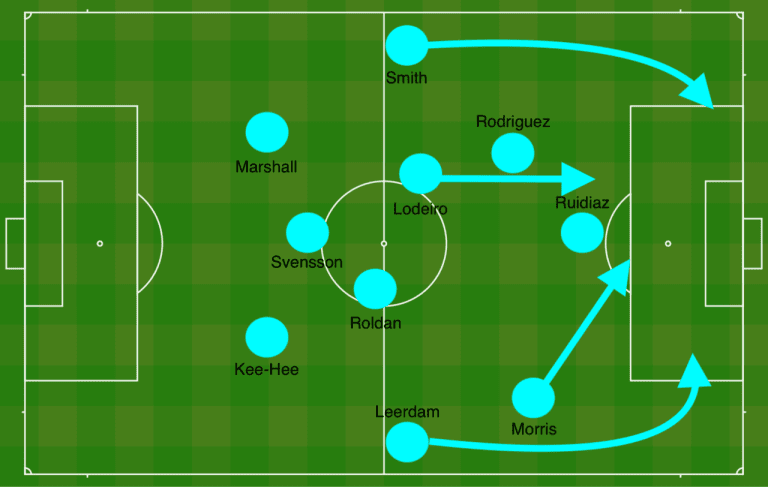The Seattle Sounders have been untouchable so far in 2019.
They’ve gathered three wins from three games, and never really looked in danger of dropping points. Calen Carr recently called them an “offensive juggernaut” on Matchday Central. They lead the league in goals per game, expected goals per game, and have generally looked capable of scoring every time they’ve touched the ball.
They have done two basic actions extremely well (lots of bullet points on this one, so buckle in):
- They’ve been lethal in transition. Five of their 10 goals in 2019 have come in moments after winning the ball or taking a quick free kick. They’ve been able to find smart passes forward out of pressure, and then they’ve had quick runs to attack the open space. They aren’t a counterattacking team, but they can counter when it’s on. Jordan Morris’ pace and direct running have helped tremendously with this.
- They have used their possession well because they crush the “Man City zones,” the areas along the sides of the 18-yard box. They use their possession to move the ball toward the corner of the 18, create a numerical advantage (by shifting over an attacking mid to pair with the winger and outside back), and annihilate teams with overlaps, give-and-goes, and 1v1 dribbling. It resembles what Manchester City have done to teams over the last couple years.
Notice where these three goals come from:
Most teams have similar ideas in mind. Seattle happen to execute them better. Why?
The Sounders nail two additional actions that other teams do not.
- They are excellent at receiving passes on the run. If you think about most teams, the players get into a spot and receive a pass to their feet. They can move the ball with their first touch, but they do it from a standing position. Now take a lot of the same actions and imagine the player is on the move, allowing himself to get to the second touch and open space quicker. The attacker has a natural advantage against the defenders either standing or moving in the other direction to close the ball. The Sounders do it more often and consistently cleaner than most teams.
- They put themselves into position to do it because they make forward runs from different layers. Morris doesn’t run to a spot and then get a pass, he waits and keeps the space open to run into. And then after Morris makes a run, and the defense has dropped, Kelvin Leerdam can make a similar late, but 10 seconds later and from 20 yards deeper.
Just when the defense thinks it has the situation handled, someone new arrives. The same movements happen on the left with Nico Lodeiro and Brad Smith (Victor Rodriguez is the one player who takes up a spot early and waits). The players hold their movements, keep the space open, and then attack the space and receive the pass on the move.
Now scroll up and watch that video again, and how each goal comes after a player makes a run from one layer to the next and takes a nearly perfect touch while moving forward.
All that movement off the ball can happen for a basic principle: Every player in the Sounders XI is comfortable on the ball under pressure. The team doesn’t have a weak link on the ball. There’s nobody who gets frazzled when he gets closed down; every player can take the extra second to allow the play to develop. As a result, teammates don’t need to check to present a short option, they can make the more goal-dangerous movement.

With all that said, there’s a concern that Seattle need to be aware of. That’s a lot of players flying forward. We could add an arrow ahead of Cristian Roldan’s name, as well. Sometimes it’s just Chad Marshall, Gustav Svensson and Kim Kee-hee behind the ball.
At some point, teams will wise up and realize they can’t usually go toe-to-toe with the Sounders (if they don’t do it in the regular season, they will in the postseason). Opponents will keep numbers behind the ball and try to catch them on the break. We haven’t seen it become an issue yet, but it’s something to keep an eye on.
If the Houston Dynamo break Alberth Elis out on the break against Svensson, for example, it’s advantage Houston. I suspect at some point in the season, we will see the Sounders pull the foot off the attacking pedal and stop sending both outside backs forward at the same time. It could even happen on Saturday against Vancouver Whitecaps FC (10 pm ET | TSN1 — Full TV & streaming info).
Until then, let’s enjoy what the Sounders have built this year. It’s something to behold.











